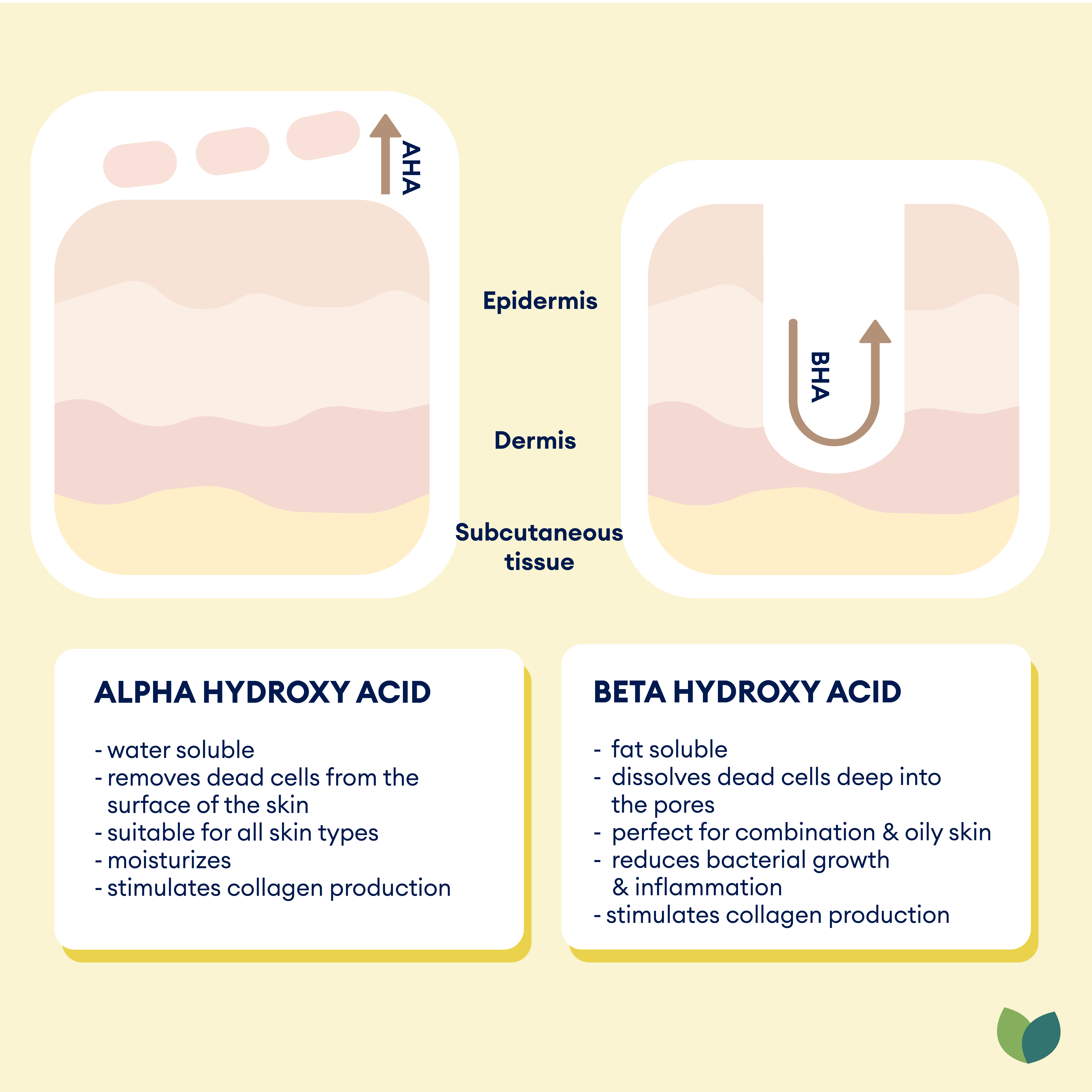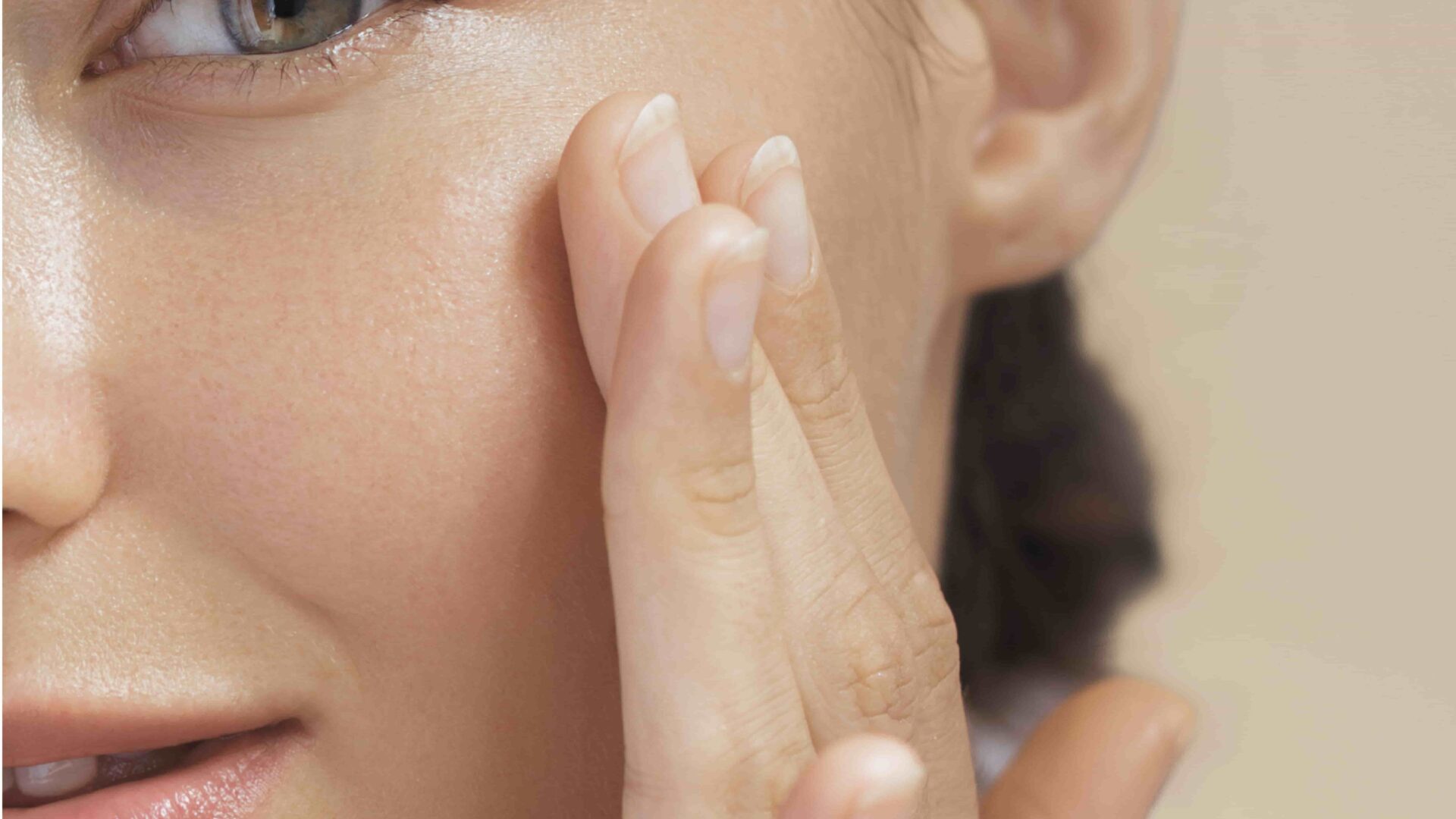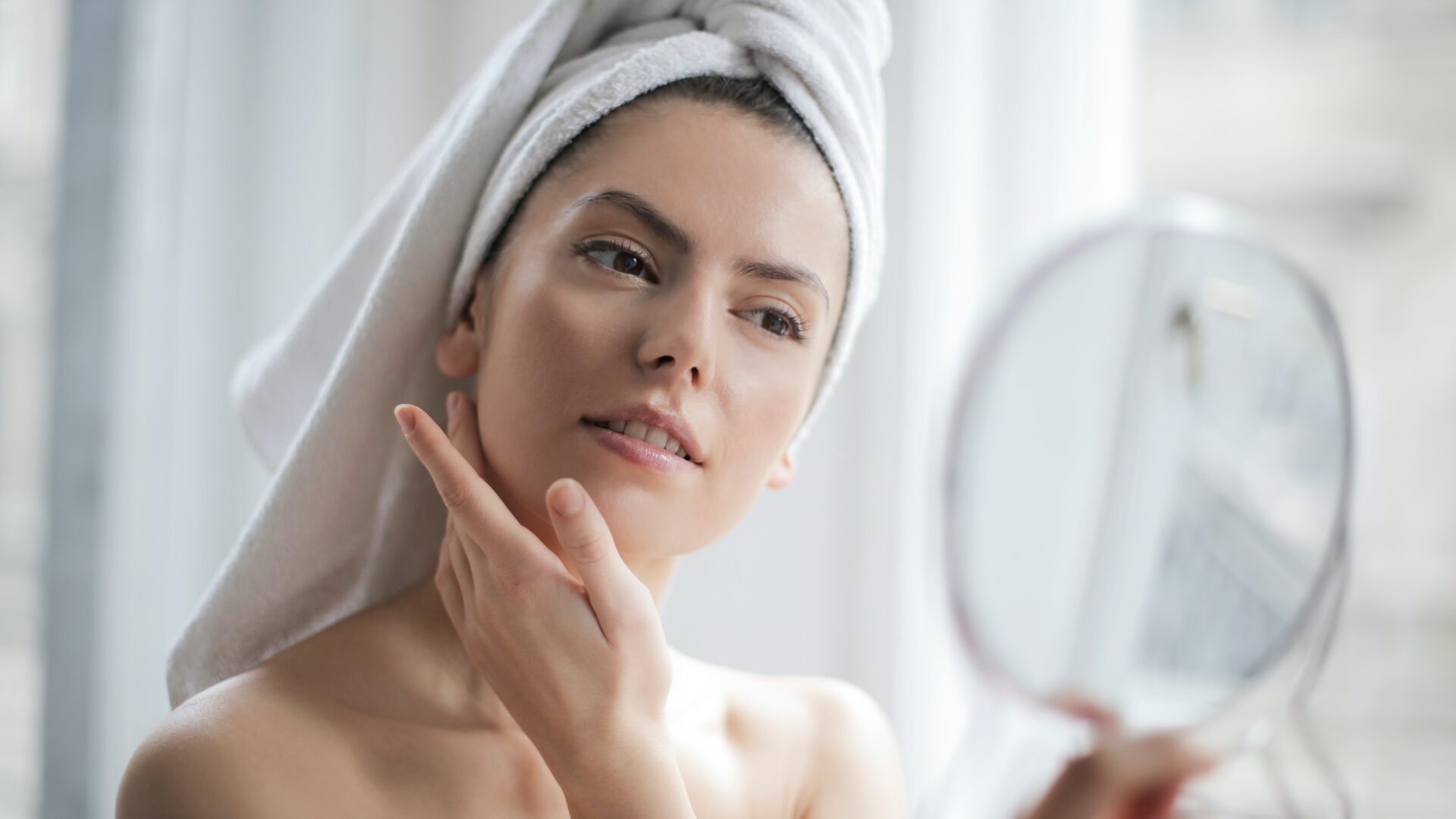"PH-what?" is probably the question many people ask when they hear about PHA. If you've ever been involved in skincare, you may have come across terms like AHA (alpha hydroxy acids) and BHA (beta hydroxy acids). These acids are known for their exfoliating properties and are an integral part of many skincare routines. But today we want to turn your attention to a lesser-known but equally exciting group of acids: poly-hydroxy acids. Read our article to find out whether PHAs are right for you.
What is PHA?
PHA is the abbreviation for poly-hydroxy acid or poly-hydroxy acid. Alongside AHAs and BHAs, PHAs form the third known group of acids that are used in skin care, among other things. However, PHAs are the new generation of AHAs, only the molecules of PHAs are larger than those of AHAs and BHAs, which makes them better tolerated and can be used by almost everyone. PHAs can be used by people who have sensitive skin, rosacea, atopic dermatitis and after cosmetic treatments. PHAs moisturise and can even improve the barrier function of the stratum corneum, unlike AHAs. (1)
Poly-hydroxy acids (PHAs) are not just another buzzword in the world of skincare. Their mode of action is based on sound chemical principles, which can make them a valuable part of your skincare routine.
Basics of the chemical structure of PHA
On a molecular level, PHAs are larger chemical compounds with multiple hydroxyl groups (-OH) on their structure. This size and structure allow PHAs to penetrate the skin more slowly than their relatives, the AHAs and BHAs. This slower penetration makes PHAs a gentler option that is less likely to cause skin irritation and explains why they are especially recommended for sensitive skin types.
Differences to AHA and BHA
- AHA (alpha hydroxy acids): AHAs are water-soluble and known for their ability to exfoliate the top layer of skin by removing dead skin cells. They are ideal for dry skin types and those seeking improved skin texture and a more even complexion.
- BHA (beta hydroxy acids): BHAs are oil-soluble, which allows them to penetrate deeper into the pores and cleanse them from the inside. They are particularly effective for oily skin and problems such as acne and blackheads.

PHAs, with their larger molecular structure, offer a gentler form of exfoliation and additional benefits such as moisturising and antioxidant properties. These unique properties make PHAs an excellent choice for almost any skin type, especially those with sensitive skin that may be irritated by traditional exfoliants.
The mild action of PHAs does not mean they are less effective. On the contrary, they work continuously to hydrate, protect and gently renew the skin, resulting in a brighter, healthier complexion without the risk of irritation that can occur with stronger acids.
Types of polyhydroxy acids
Poly-hydroxy acids (PHAs) come in various forms, each offering unique properties and benefits for skincare. Whilst they are all grouped under the umbrella of PHAs, the individual acids have specific effects, which make them suitable for different skin needs and goals. In this section, we introduce you to the most well-known PHA types.
Gluconolactone
Gluconolactone is one of the most commonly used polyhydroxy acids in skin care products. If a skin care product contains PHA or PHA is mentioned, then gluconolactone is usually used and meant.
It is known for its antioxidant properties and its ability to protect the skin from harmful environmental influences. Gluconolactone also has a moisturising effect and supports the skin barrier, making it an excellent choice for dry or sensitive skin. In addition, it has a mild exfoliating effect that helps to improve skin texture and promote a radiant complexion.
Gluconolactone is so gentle that even high concentrations are well tolerated. An important study found that 15% azelaic acid combined with a 10% gluconolactone moisturiser significantly improved erythema (i.e. redness caused by inflammation) in rosacea patients. The combination has a better effect than azelaic acid alone.
Another study compared 14% gluconolactone with 5% benzoyl peroxide in 150 study participants. Benzoyl peroxide is considered one of the best active ingredients for acne. The study showed that gluconolactone is comparable to benzoyl peroxide, but much gentler with hardly any side effects, such as skin irritation and dryness (2).
This means that gluconolactone is not only an effective moisturiser, but also an excellent active ingredient for acne. It is also a good exfoliant for all skin types.
Gluconolactone is so well tolerated that it can be used in a concentration of 15% as a leave-on peeling. A concentration of 30% is compatible with wash-off formulations. Sensitive skin benefits from even 2% (3).
Many gluconolactone products are combined with other active ingredients, so you should be careful when purchasing or using them so as not to accidentally mix too many active ingredients at once.
You should generally use exfoliants in the evening. Gluconolactone, or PHAs, can even be used in the morning. However, it is always better to be safe than sorry when starting to use them, so carry out a patch test first. Most people can tolerate concentrations of 7% to 10% right from the start.
Lactobionic acid
Lactobionic acid is another PHA, which is often praised for its moisturising and antioxidant properties. It can help maintain the skin’s moisture levels, whilst protecting against oxidative stress. Lactobionic acid is particularly beneficial for those looking for an effective anti-ageing component in their skincare routine, as it can help reduce the appearance of fine lines and wrinkles.
Other common PHA types
- Maltobionic acid: Similar to lactobionic acid, it offers antioxidant benefits and supports moisture retention in the skin.
- Galactose: A less commonly used PHA, which can promote skin renewal and help improve skin texture.
Each of these PHA types offers specific skincare benefits, from moisturising and antioxidant properties to supporting skin renewal and improvement. Their mild nature makes PHAs an excellent choice for a variety of skin types and conditions, especially those sensitive to stronger acids.
Benefits of PHA for the skin
Polyhydroxy acids (PHAs) offer a wealth of skin benefits, which make them an attractive option for almost any skin type and skincare routine. Their unique properties and gentle effects on the skin set them apart from other chemical exfoliants. Here are some of the most notable benefits PHAs can have on your skin.
Moisturising properties
One of the key features of PHAs is their ability to bind and retain moisture in the skin. This moisturising effect helps to keep the skin plump and hydrated, which is particularly beneficial for dry or dehydrated skin types. Unlike other chemical exfoliants that can dry out the skin, PHAs promote a healthy moisture balance.
Mild peeling effects
PHAs provide a gentle exfoliating effect, which removes dead skin cells from the surface without irritating the skin. This gentle resurfacing helps to improve the appearance of fine lines, wrinkles and uneven skin tone. It also promotes a smoother and more radiant skin texture, achieved without the risk of redness or irritation.
Antioxidant effect
Many PHAs have antioxidant properties, which can help the skin to protect itself from harmful environmental influences and free radicals. This antioxidant effect supports overall skin health and can help prevent premature skin ageing.
Suitable for sensitive skin
Due to their large molecular structure and slower penetration into the skin, PHAs are particularly suitable for sensitive skin types. They cause less irritation than other chemical exfoliants, making them an excellent choice for people with sensitive skin or those who are sensitive to AHAs or BHAs.
Disadvantages of PHA for the skin
Everything, which is new, is little researched and therefore the long-term effects are not exactly known. In the case of PHAs, this means that we do not yet know exactly how effective they are for anti-ageing, i.e. especially for fine lines and hyperpigmentation. The gold standard, where we are really sure of the effect, are AHAs, especially glycolic acid.
Apart from that, there are no known disadvantages to PHAs and we highly recommend them.
Applications of PHA in skin care
With their numerous benefits, poly-hydroxy acids (PHAs) are versatile skincare ingredients. Their mild nature makes them an ideal choice for a variety of products, from daily cleansers to specialised treatments. Here’s how to incorporate PHAs into your skincare routine and get the most out of these powerful ingredients.
Daily skin care and cleansing
PHA-enriched cleansers and moisturisers are a great way to start your skincare routine. They provide gentle cleansing and hydration without irritating or drying out the skin. Daily use of such products can help keep skin smooth and hydrated, whilst supporting its natural renewal process.
Professional treatments and peelings
For those looking to take their skincare to the next level, professional PHA treatments and peels can be considered. These treatments, often offered at skin care clinics and spas, utilise higher concentrations of PHAs to achieve more intense exfoliation and rejuvenation effects. They can be particularly beneficial to address specific skin concerns, such as fine lines, wrinkles and uneven skin tone.
PHA in anti-ageing products
Due to their antioxidant properties and ability to improve skin texture, PHAs are a popular choice in anti-ageing products (4). They can help reduce the visible signs of ageing by smoothing, moisturising and protecting the skin from environmental damage. Incorporating PHA-containing serums or creams into your routine can be an effective strategy to promote a more youthful appearance.
PHA is particularly suitable for:
- Beginners, who are new to chemical peels,
- People with dry skin, which is prone to irritation,
- for anyone, for whom AHAs and BHAs have not worked so well,
- retinoid users, who would like to integrate other active ingredients into their routine.
PHA is less suitable for:
- People, who already use other chemical peels,
- AHA long-term users,
- all those who already regularly receive professional chemical peels, as additional active ingredients are too much in everyday life.
Tips for the use of PHAs
- Start slowly: If you’re new to PHAs or chemical exfoliants in general, start slowly to get your skin used to the product. Start with a low concentration and gradually increase it when your skin shows no irritation.
- Sun sensitivity: Although PHAs are considered milder, they can increase the skin’s sensitivity to the sun. It is important to use a sunscreen with a high sun protection factor (SPF) during the day to protect your skin. At least SPF 30, preferably SPF 50.
- Consider skin type: Whilst PHAs are suitable for most skin types, it is always advisable to choose products, which are tailored to the specific needs of your skin.
PHA-containing products offer a gentle, effective way to improve the health and appearance of your skin. By incorporating these versatile ingredients into your skincare routine, you can benefit from their moisturising, renewing and protective benefits.
Comparison of PHA with other acids
Polyhydroxy acids (PHAs) are a gentle, but effective alternative to the more traditional chemical exfoliants, alpha-hydroxy acids (AHAs) and beta-hydroxy acids (BHAs). Although they can all help improve skin texture and health, these acids differ in their mode of action and specific benefits. Understanding these differences can help you make the best choice for your skincare routine.
PHA vs. AHA (alpha-hydroxy acids)
- Mode of action: Both PHAs and AHAs provide exfoliation by removing dead skin cells from the skin’s surface. AHAs, which are smaller in molecular size, can penetrate deeper into the skin, resulting in more exfoliation. PHAs, on the other hand, act more superficially and are therefore milder on the skin.
- Skin types: AHAs are particularly good for dry skin types as they help to renew the top layer of skin and make the skin smoother. PHAs are ideal for sensitive skin types due to their gentle nature and moisturising properties.
PHA vs. BHA (beta-hydroxy acids)
- Solubility: BHAs are oil-soluble, which allows them to penetrate deeper into the pores and cleanse them from the inside. This makes them particularly effective in treating oily skin and acne. PHAs, like AHAs, are water soluble, but their larger molecular structure limits their ability to penetrate deep into the skin, making them less aggressive.
- Skin problems: BHAs are ideal for people with oily skin, clogged pores and pimples as they help to combat these issues. PHAs are an excellent choice for a wide range of skin conditions, including sensitive skin, due to their moisturising and antioxidant properties as well as their ability to gently exfoliate.
Choosing the right acid for your skin type
The choice between PHA, AHA and BHA ultimately depends on your skin type and your specific skin needs. If you have sensitive skin or are new to the world of chemical exfoliation, PHAs may be the best place to start. They offer a gentler alternative that is still effective at renewing and hydrating the skin without irritating it.
For those with dry skin, AHAs may be the better option to improve skin texture and moisturise. And if you have oily skin, blackheads, pimples or acne, BHAs may be most effective due to their ability to penetrate deep into the pores and cleanse them.
Whichever acid you choose, it is important to use sun protection as chemical exfoliants can increase the skin’s sensitivity to the sun. Start slowly and observe how your skin reacts to find the best solution for your individual needs.
Possible side effects and precautions
Although poly-hydroxy acids (PHAs) are known for their gentle action and good tolerability, even on sensitive skin, it is important, as with any skincare product, to be aware of potential side effects and take appropriate precautions. Here’s what you need to know about the safe use of PHA-containing products.
Skin reactions and sensitivities
Whilst PHAs are generally less irritating than other chemical exfoliants, such as AHAs and BHAs, some people may still be sensitive to them, especially on first application. Possible skin reactions may include mild redness, a tingling sensation or dryness. However, these symptoms should be mild and subside quickly. If a severe or persistent reaction occurs, it is advisable to discontinue use and consult a dermatologist.
Application tips and protective measures
- Patch test: Always carry out a patch test before incorporating a new product into your skincare routine. Apply a small amount of the product to an area of your skin, which is not normally visible and wait 24 hours to observe any allergic reactions.
- Slow introduction: Start with a lower concentration of PHAs and only use the product a few times a week at first. This will allow your skin to gradually get used to the new ingredient.
- Sun protection: Chemical exfoliants, including PHAs, can increase the skin’s sensitivity to the sun. Use a broad spectrum sunscreen with a high sun protection factor (SPF) daily to protect your skin from UV damage.
- Observe your skin: Pay attention to your skin’s reactions when you start using products containing PHA. If you notice irritation, reduce the frequency of application or switch to a product with a lower concentration.
Combination with other products
Be careful when combining PHAs with other active ingredients, especially those that can also exfoliate or potentially irritate the skin, such as retinoids or vitamin C. Combining too many active ingredients can overload the skin and cause irritation. It may be helpful to consult a skincare professional to create a plan, which maximises the benefits and minimises the risk of side effects.
PHAs are an excellent addition to many skincare routines, thanks to their mild effects and wide range of benefits. By taking the right precautions and paying attention to your skin’s needs, you can enjoy the positive effects of PHAs without risking unwanted side effects.
Conclusion
Polyhydroxy acids (PHAs) are an exciting and promising component in the world of skincare, offering a gentle alternative to traditional chemical exfoliants. Their moisturising, antioxidant and skin-soothing properties make them an excellent choice for a variety of skin types, especially those with sensitive skin. By incorporating PHA-containing products into your skincare routine, you can enjoy the multiple benefits of these powerful ingredients and contribute to healthier, more radiant skin.
Frequently asked questions
Yes, products containing PHAs can usually be used daily, as they are considered gentle exfoliants. Their larger molecular structure allows for slower penetration into the skin, which minimises the risk of irritation. However, it is important to pay attention to your skin’s reaction and reduce use if redness or dryness occurs. Start with a lower concentration and frequency to acclimatise your skin to the product.
PHAs are suitable for almost all skin types, including sensitive skin, due to their mild nature and moisturising properties. They are particularly beneficial for people who are sensitive to stronger exfoliants such as AHAs and BHAs. However, it is advisable to choose products that are tailored to the specific needs of your skin type and consult a dermatologist if you are unsure.
PHA-containing products can easily be integrated into any skincare routine. Start with a PHA-containing cleanser or toner as the base of your routine. You can then add a PHA serum or moisturiser for extra hydration and nourishment. It is important to complement the use of PHA products with a sunscreen in the morning, as exfoliants can increase the skin’s sensitivity to the sun.
The time it takes to see results from PHA-containing products can vary depending on your skin type, the specific product and how often you use it. Some people notice improvements in texture and hydration within a few weeks, while others may take longer to see significant changes. Patience and consistency are key to success when using PHAs in skincare.
PHAs can usually be safely combined with other skincare ingredients, but caution is advised to avoid over-exfoliation and skin irritation. It is recommended not to use PHAs at the same time as other strong exfoliants, such as high concentrations of AHAs, BHAs or retinoids. When combining PHAs with other active ingredients, it is best to consult a skincare professional to develop a safe and effective routine.
Edison, Brenda L.Smith, Heather A.Green, Barbara A.Tierney, Neena K. et al.
Journal of the American Academy of Dermatology, Volume 85, Issue 3, AB165.


